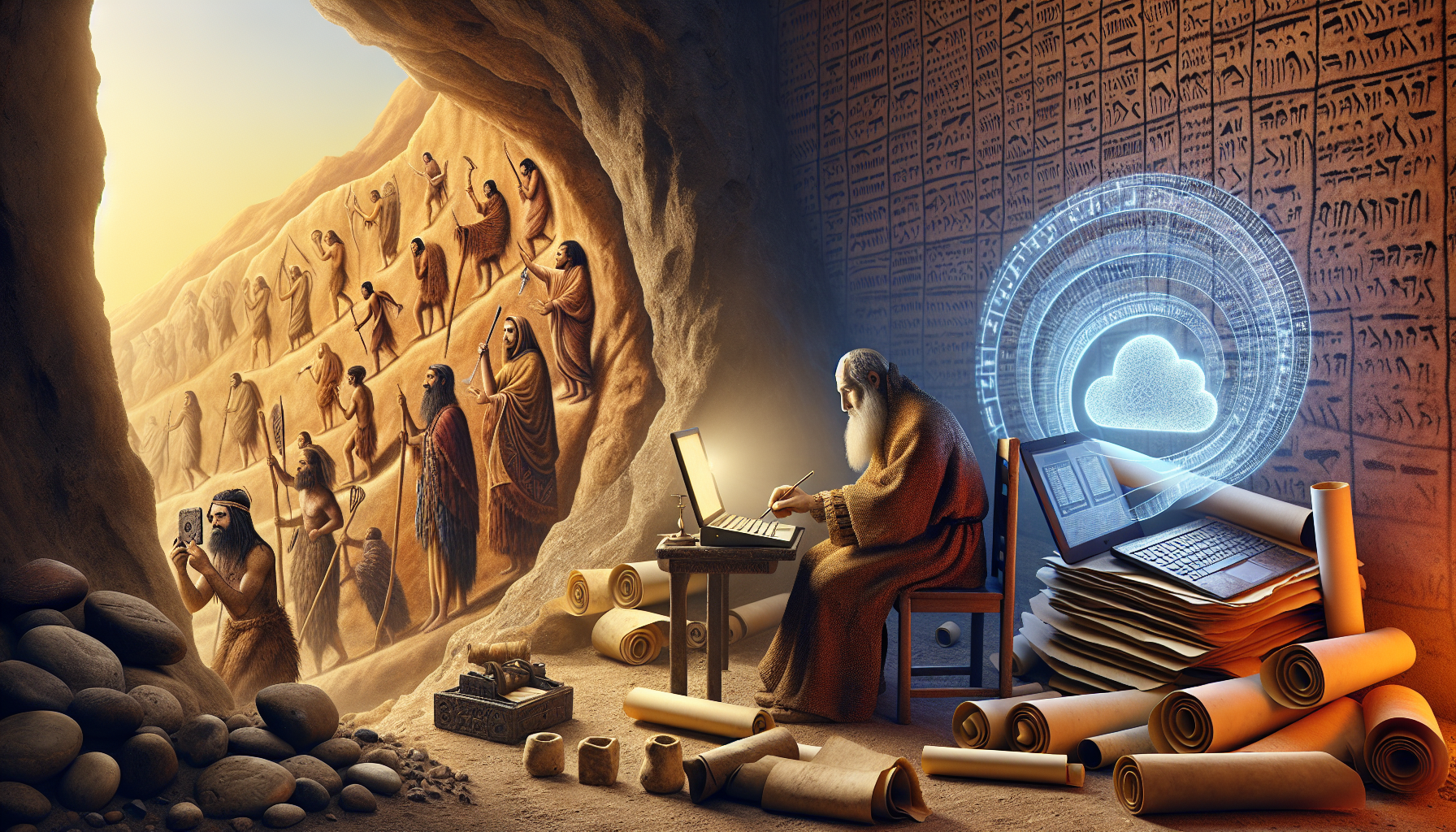In the vast tapestry of human history, few inventions have had as profound an impact as the development of writing and record keeping. From the earliest etchings on cave walls to the intangible data floating in the cloud, the journey of recording human thought, creativity, and information is nothing short of extraordinary. It’s a story that not only chronicles the evolution of technology but also the evolution of human civilization itself. 📜✨
Imagine standing in a dimly lit cave thousands of years ago, watching as our ancestors painted their stories with ochre and charcoal, capturing their world and beliefs on stone surfaces. These early artists were the pioneers of record keeping, using primitive yet powerful symbols to communicate their experiences. Fast forward to ancient Mesopotamia, where the invention of cuneiform on clay tablets marked a significant leap in the sophistication of writing. Here, we witness the transition from mere symbols to a complex system capable of conveying laws, trade transactions, and epic tales.
As we journey through the ages, the Egyptian hieroglyphs enchant us with their pictorial beauty, while the alphabetic systems of the Phoenicians and Greeks lay the foundation for the modern alphabets that most of us use today. Each of these milestones not only reflects advancements in technology but also shifts in cultural paradigms and the expansion of human knowledge. The Roman Empire, with its vast bureaucracy, further refined record keeping, setting standards that would influence administrative practices for centuries.
The invention of paper in China and the subsequent development of the printing press in the 15th century revolutionized the way information was disseminated. Suddenly, the written word was no longer the exclusive domain of the elite. Books became accessible to the masses, igniting a thirst for knowledge and setting the stage for the Enlightenment and the scientific revolution. This democratization of information laid the groundwork for the modern world, where record keeping evolved to include everything from scientific journals to newspapers and novels, each playing a crucial role in shaping societies.
Today, we find ourselves in the digital age, where bytes and bits have replaced ink and parchment. The advent of computers and the internet has propelled us into a realm of virtual storage and cloud computing, where information is not only abundant but also instantly accessible. Yet, as we embrace this new frontier, we must also consider the implications of digital record keeping on privacy, security, and the very nature of memory. From cave paintings to cloud storage, the evolution of writing and record keeping is a testament to humanity’s unyielding quest to capture the essence of existence and share it with generations to come. 🌍💾
The Dawn of Writing: From Cave Paintings to Cuneiform
The history of writing is a fascinating journey that begins with the early cave paintings, where humans first expressed their need to communicate visually. These paintings, found in various parts of the world, such as the famous ones in Lascaux, France, were more than just art; they were an early form of record-keeping. These ancient murals depicted scenes of hunting, rituals, and daily life, providing a glimpse into the minds of our prehistoric ancestors. The transition from these paintings to written language was not abrupt but rather a gradual evolution of thought and necessity.
Cave paintings served as the primary medium for communication long before the advent of written scripts. They were essentially the first step in the evolution of writing, setting the stage for more sophisticated forms of documentation. As societies evolved, so did their communication needs. The development of agriculture, trade, and governance required a more structured way to keep records. This necessity led to the creation of more formal writing systems. It was in Mesopotamia that cuneiform, one of the earliest forms of writing, emerged around 3200 BCE. This script, inscribed on clay tablets, represented a significant leap from pictorial representations to a symbolic language that could capture more complex ideas.
The invention of cuneiform had profound implications for society. It allowed for the recording of laws, transactions, and literature, which played a critical role in the administration of early states and empires. The ability to document and disseminate information helped in the centralization of power and the advancement of civilization. Moreover, writing systems like cuneiform were instrumental in preserving the history and culture of these ancient societies, providing a bridge to the past that continues to inform our understanding of human development today.
The Papyrus Revolution: Egypt’s Contribution to Record Keeping
As we delve deeper into the evolution of writing, the role of Egypt stands out, particularly with the development of papyrus as a writing material. Around 3000 BCE, the Egyptians began using papyrus, a plant native to the Nile Delta, to create a portable and durable writing surface. This innovation was revolutionary, transforming the way records were kept and information was shared. Papyrus was lightweight, easy to produce, and could be rolled up for storage, making it an ideal medium for various kinds of documentation, from administrative records to religious texts.
The use of papyrus and the development of hieroglyphs were closely linked. Hieroglyphs, the pictorial writing system of ancient Egypt, were both artistic and functional, allowing for the recording of a wide range of information. The Egyptians used papyrus extensively for everything from recording tax collections and legal contracts to creating literary works and religious manuscripts. This combination of material and script was crucial in maintaining the bureaucratic structure of ancient Egypt, supporting its complex society and enduring culture.
Moreover, the influence of papyrus extended beyond Egypt. As the use of papyrus spread throughout the Mediterranean, it became a critical component of record-keeping and administration in other cultures. The exchange of goods and ideas facilitated by this material helped lay the groundwork for the interconnected world we know today. The importance of papyrus in the evolution of writing cannot be overstated; it was a pivotal development that enabled the growth of literacy and bureaucracy across ancient civilizations.
The Alphabetic Leap: From Phoenicians to Greeks
The next significant milestone in the history of writing was the development of the alphabet. This breakthrough is credited to the Phoenicians, a maritime trading culture that flourished around 1200 BCE in the region of modern-day Lebanon. The Phoenician alphabet was a game-changer; it was the first writing system to use symbols to represent individual sounds rather than words or syllables. This phonetic approach made writing more accessible and adaptable, allowing it to be learned and used by a broader segment of the population.
The Greek adoption and adaptation of the Phoenician alphabet marked another turning point. The Greeks added vowels to the consonantal Phoenician script, creating a complete alphabet that could represent the full range of sounds in their language. This innovation made reading and writing easier, contributing to the spread of literacy and the flourishing of Greek culture. The Greek alphabet laid the foundation for the Latin script, which would later become the basis for many modern writing systems.
The impact of the alphabet on society was profound. It democratized writing, enabling not just scribes and scholars but ordinary people to record information, share ideas, and express themselves. The ease and efficiency of alphabetic writing facilitated the documentation of scientific discoveries, philosophical ideas, and historical events, paving the way for the Renaissance and the Enlightenment. The alphabet was a critical development that accelerated the pace of communication and cultural exchange, shaping the world in profound ways.
The Manuscript Era: Monasteries and Medieval Scribes
The fall of the Roman Empire and the ensuing medieval period brought about changes in the world of writing and record-keeping. During this time, monasteries became the primary centers of literacy and learning in Europe. Monks dedicated themselves to the laborious task of copying manuscripts by hand, preserving not only religious texts but also the literary and scientific knowledge of antiquity. This era, often referred to as the Manuscript Age, was crucial for the survival and transmission of cultural heritage through the ages.
Medieval scribes developed their own distinct styles and techniques, using materials like parchment and vellum, which were more durable than papyrus. Illuminated manuscripts, with their intricate decorations and colorful illustrations, are a testament to the skill and artistry of these scribes. These works were not merely copies of existing texts; they were seen as devotional acts, with each manuscript representing months or even years of meticulous effort. The preservation of knowledge during this period relied heavily on the dedication and expertise of these monastic scribes.
The importance of manuscripts in the medieval era cannot be overstated. They were the primary means of preserving and disseminating knowledge in a world where printed books did not yet exist. The labor-intensive process of hand-copying texts limited the availability of written works, but it also ensured their survival through times of upheaval and change. Monasteries played a pivotal role in maintaining the continuity of knowledge, providing a bridge between the ancient and modern worlds.
The Printing Revolution: Gutenberg and Beyond
The invention of the printing press by Johannes Gutenberg in the mid-15th century was a landmark event in the history of writing and record-keeping. This technological innovation transformed the production of books, making them more accessible and affordable than ever before. Gutenberg’s press used movable type, allowing for the mass production of texts, which revolutionized the spread of information and ideas. The printing revolution played a crucial role in the spread of literacy and the democratization of knowledge, laying the groundwork for the modern information age.
The impact of the printing press was immediate and far-reaching. It facilitated the dissemination of new ideas and scientific discoveries, contributing to the intellectual and cultural upheavals of the Renaissance and the Enlightenment. The availability of printed books made education more accessible, allowing a wider audience to engage with new concepts and participate in the cultural and intellectual life of the time. The printing press broke the monopoly of the scribes, empowering individuals to become authors and publishers in their own right.
The legacy of the printing revolution continues to influence the way we communicate today. The ability to reproduce and distribute written works on a large scale paved the way for the development of newspapers, magazines, and eventually digital media. The printing press was a catalyst for change, transforming societies and economies and laying the foundation for the global exchange of information that defines our modern world.
For a visual exploration of the history of writing, check out this engaging video: The Evolution of Writing: From Cuneiform to Digital (YouTube) 📜
From Pen to Cloud: The Digital Age of Record Keeping
With the advent of the digital age, the nature of writing and record-keeping has undergone another dramatic transformation. The transition from traditional to digital media has been characterized by the move from paper-based systems to electronic formats, offering unprecedented speed, efficiency, and accessibility. The rise of computers, the internet, and cloud storage has revolutionized the way information is created, shared, and preserved, ushering in a new era of connectivity and collaboration.
| Medium | Advantages | Challenges |
|---|---|---|
| Papyrus | Durable, Portable | Limited Lifespan, Susceptible to Climate |
| Manuscripts | Detailed, Artistic | Labor-Intensive, Limited Distribution |
| Printed Books | Mass Production, Affordable | Resource-Intensive, Physical Storage Required |
| Cloud Storage | Accessible, Scalable | Security Concerns, Requires Internet |
As we continue to navigate the digital landscape, it is essential to consider the implications of this transition for future generations. The shift from traditional to digital record-keeping offers immense opportunities but also poses challenges, such as data security and the preservation of digital information. As we look to the future, it is crucial to balance the benefits of technological advancement with the responsibility to safeguard and sustain the legacy of human knowledge.
- Explore the development of writing from ancient scripts to modern alphabets.
- Understand the impact of the printing press on literacy and knowledge dissemination.
- Consider the implications of cloud storage for future record-keeping.
For a deeper dive into the digital transformation of writing, watch this insightful video: The Digital Revolution in Writing (YouTube) 🌐

Conclusion
Crafting a compelling conclusion for a topic as vast and profound as the evolution of writing and record keeping is no small feat. The journey from primitive cave paintings to sophisticated cloud storage encapsulates the remarkable progress of human civilization. This exploration not only highlights our relentless pursuit of innovation but also underscores the intrinsic human need to communicate, preserve, and share knowledge across generations.
Throughout history, writing and record-keeping have served as the backbone of cultural and intellectual development. Starting with the earliest cave paintings, our ancestors began to depict their experiences, beliefs, and stories through simple, yet profound imagery. These artworks were not just expressions of daily life but were also essential tools for communication and education within communities. As we moved from pictographs to the development of written languages, such as cuneiform and hieroglyphics, we saw the dawn of more complex record-keeping systems that enabled the administration of early societies and the transmission of culture and knowledge.
The invention of the printing press marked a revolutionary shift, democratizing information and fueling the dissemination of ideas on an unprecedented scale. This pivotal moment laid the groundwork for the Enlightenment and the rapid advancement of science, philosophy, and art. In more recent times, the digital revolution has transformed our approach to writing and record-keeping, bringing about the rise of cloud storage and digital archives. These technologies have not only enhanced accessibility and efficiency but have also introduced new challenges and considerations, such as data security and digital preservation.
The importance of understanding this evolution cannot be overstated. By appreciating the history of writing and record-keeping, we gain insight into the continuous interplay between technology and human expression. It reminds us of our shared heritage and the ways in which communication shapes our society. Moreover, as we stand on the precipice of further advancements, such as artificial intelligence and blockchain technology, recognizing the past equips us to navigate future developments with wisdom and foresight.
To the readers who have embarked on this journey through time, I encourage you to reflect on the significance of writing and record-keeping in your own lives. Whether you’re a writer, historian, technologist, or simply an enthusiast of human progress, consider how these practices impact your daily interactions and the legacy you wish to leave behind. Engage with this topic by sharing your thoughts and experiences. Discuss how modern tools have transformed your approach to information and creativity. Furthermore, consider the ethical implications of digital records and the responsibility we bear in preserving the integrity of information for future generations.
Share this knowledge with others, sparking discussions about the evolution of communication and its role in shaping our world. By doing so, you not only honor the rich history of writing and record-keeping but also contribute to the ongoing dialogue about the future of information sharing.
Finally, embrace the opportunities that modern technologies offer while remaining mindful of the lessons from the past. Just as our ancestors adapted to new forms of expression, so too must we navigate the digital landscape with curiosity and caution. The tools we use today are merely the latest chapter in a long story of human ingenuity and adaptability. Let us write this chapter with care, creativity, and a deep appreciation for the journey that brought us here. 🌟
For further exploration, consider delving into reputable sources such as the British Library’s collection on writing history (British Library) and the Smithsonian’s insights on technological advancements in record-keeping (Smithsonian).
In conclusion, the evolution of writing and record-keeping is a testament to the enduring power of human expression. It is a story of innovation, resilience, and the perpetual quest to connect with others. As we continue to write our own stories, let us do so with purpose and passion, ever mindful of the legacy we are creating for future generations. 📚💡
Toni Santos is a visual storyteller and cosmic interpreter whose work illuminates the ancient skywatchers and their prehistoric astronomy—the profound ways early humans observed and revered the heavens before written history. Through a visionary lens, Toni explores how the stars, planets, and celestial cycles shaped myth, ritual, and survival in cultures lost to time.
Rooted in a fascination with archaic observatories, stone alignments, and celestial symbolism, Toni’s creative journey reveals the deep human impulse to understand and harmonize with the cosmos. From lunar phases guiding planting seasons to the sacred paths of the Milky Way, each of his works embodies the awe and knowledge encoded in the night sky.
Combining artistic craftsmanship with archaeological insight, Toni’s pieces evoke the mystery and precision of prehistoric astronomers. His work does more than depict—it channels the timeless dance between earth and sky, bridging ancient wisdom with contemporary wonder.
As the visionary behind Vizovex, Toni shares curated visuals, essays, and symbolic studies that invite others to reconnect with the cosmic heritage written in stone and starlight. His creations are a call to look upward, to listen to the silent stories told by the stars, and to honor the first astronomers who mapped the heavens with reverence and ingenuity.
His work is a tribute to:
The celestial wisdom of prehistoric peoples
The sacred geometry of ancient observatories
The enduring bond between human culture and the cosmos
Whether you’re a stargazer, a scholar of ancient mysteries, or someone captivated by the universe’s earliest storytellers, Toni welcomes you to journey through a space where the sky is both map and myth—one constellation, one ritual, one revelation at a time.




